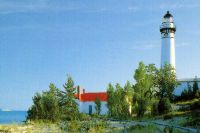... Lee mentioned South Manitou Island, and I can think of
no better place to begin describing old growth stands than this
unique
area.

South Manitou Island Lighthouse, NPS photo
I visited the island in July 2002. In order to get there, you
have to
take a 17 mile trip out into Lake Michigan on the ferry that
runs daily
to the island from Leland, MI. The more adventurous can actually
kayak
out to the island on days when the lake is not too rough. Once
off the
ferry, it's a couple miles of hiking (either on an inland trail
or along
the southern beach) to get to the trees. As far as I know, the
NPS
allows no motorized vehicles anywhere on the island. There was
just
enough time for me to get there, explore the trees, and get back
for a
quick tour of the lighthouse before the ferry departed back to
the
mainland.
The Eastern White Cedar trees here are unique, at least for
lower
Michigan. The former world champion, with a published CBH of 17
feet,
has died and the top has fallen, but there are several others
almost as
large. I did not take any measurements of height, but I would
estimate
the tallest trees are in the 100-110 foot range. I saw about 20
acres of
old growth from the trail that winds through here and there is
probably
more, but since I was worried about getting back in time to
catch the
ferry, I stayed on the marked trail. Other old growth species I
noted
included beech and some really large and gnarled sugar maples. A
couple
other things I noticed;
This area is in a valley that is protected from strong winds off
Lake
Michigan by a tall (wooded) sand dune. In fact, even though it
was a
fairly breezy day along the beach, I noticed little or no wind
in the
old growth, even at tree top level. The trees did not appear
wind
stressed at all. One of the theories offered as to why the trees
were
never cut was that sand from the dunes had been embedded in the
bark by
strong winds and the lumbermen didn't want the sand to dull
their saws.
I am not sure if things were different a century ago, but there
was no
sand in the bark of these trees in 2002.
The other thing that struck me was the total lack of young cedar
trees.
The only cedars here were the big ones, 3-5 feet DBH. No smaller
ones,
no seedlings at all. There was a stand of second growth cedar
about a
mile away along the beach, but no smaller cedars in the old
growth
stand.
Here are some websites that have photos of the trees:
http://www.leelanau.com/manitou/islands/cedar.html
http://www.charliet.net/PhotoPages/ValleyoftheGiants.htm
The last link has a photo of the (dead) champion white cedar as
well as
a published height of 113 feet to go along with the 216 inch
CBH. These
measurements were from 1978.
I did take some video of the trees, including the old maples and
I am in
the process of learning how to convert video to stills which I
can post
at some point in the future.
Ernie
Ostuno
Here are
two additional links for the National Park Service Sites.
South Manitou Island is a part of Sleeping Bear Dunes National
Lakeshore in Michigan. The NPS site reads in part, "On
South Manitou Island there is a small stand of very large,
pre-Columbian northern white cedar. This 40-acre grove has some
cedars that are 100 feet tall with 60-inch diameter trunks. The
grove appears to have been larger but is being gradually
succeeded by hardwoods." The first link contains a
map of the island.
http://www.nps.gov/slbe/SMI_page.htm
http://www.nps.gov/slbe/index.htm
Edward Frank
|